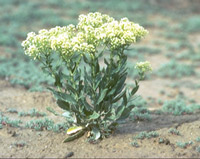|
Hoary Cress (Whitetop) Cardaria draba |
|||||||||||

|
Key Characteristics
|
|||||||||||

|
|
|||||||||||
|
This information courtesy of the Colorado Natural Areas Program Family: Brassicaceae (Mustard)Other Names: heart-podded hoary cress, pepperweed, whitetop USDA Code: CADR Legal Status: Colorado Noxious Weed List B Identification Growth form: perennial forb Flower: Numerous white flowers with four petals, give the plant a white, flat-topped appearance. Seeds/Fruit: Seed capsules are heart shaped, and contain two reddish-brown seeds. Leaves: Leaves are alternate, 1.6-4 inches long, blue green in color, and lance-shaped. Lower leaves are stalked, while the upper leaves have two lobes clasping the stem. Stems: Mature hoary cress plants are up to two feet tall with erect stems. Roots: Roots are rhizomatous and usually occur at depth of 29-32 inches, but have been recorded to penetrate to a depth of 30 feet in the Pacific Northwest (FEIS 1998). Seedling: No information available. Similar Species Exotics: Two other closely related species Cardaria pubescens and Cardaria chalapa are designated as noxious weeds in some states (Sheley and Stivers 1999). Natives: None known. Impacts Agricultural: Hoary cress is generally considered unpalatable to livestock. Ecological: Hoary cress is invading rangelands throughout North America. It is a highly competitive weed once it becomes established. Hoary cress spreads primarily by extremely persistent roots and will eventually eliminate desirable vegetation and become a monoculture. Habitat and Distribution General requirements: Hoary cress is typically found on generally open, unshaded, disturbed ground. Hoary cress grows well on alkaline soils that are wet in late spring and generally does better in areas with moderate amounts of rainfall. It is widespread in fields, waste places, meadows, pastures, croplands, and along roadsides (FEIS 1998). Hoary cress is commonly found in saltcedar (Tamarix spp.), antelope bitterbrush / rough fescue (Purshia tridentata / Festuca scabrella), antelope bitterbrush / bluebunch wheatgrass (Pseudoroegneria spicata), big sagebrush (Artemisia tridentata spp.), and Wyoming big sagebrush (Artemisia tridentata ssp. wyomingensis) communities (FEIS 1998). Distribution: It is widespread in the United States except along the southern boundary of the western and south-central states (USDA 1971). In Colorado, hoary cress is commonly found at elevations of 3,500 to 8,500 feet. Historical: Hoary cress is a weed of Eurasian origin. Biology/Ecology Life cycle: The root system of hoary cress consists of vertical and lateral roots from which new rosettes and flowering shoots arise (Mulligan and Findlay 1974). Plants emerge in very early spring. The first leaves appear aboveground 5 to 6 weeks after planting (Mulligan and Findlay 1974, FEIS 1998). During this period, the first leaves emerge and form a loose rosette (Mulligan and Findlay 1974, FEIS 1998). Stems arise from the center of each rosette in late April (FEIS 1998). Plants flower from May to June, are self-incompatible, and are pollinated by insects. Hoary cress plants set seed by mid-summer (Whitson et al. 1996). If conditions are favorable, a second crop of seeds can be produced in the fall (Sheley and Stivers 1999). Mode of reproduction: Reproduces both by seeds and vegetatively. Hoary cress spreads vigorously by creeping roots (FEIS 1998). Within three weeks of germination, a seedling root can begin producing buds (FEIS 1998). One plant can eventually result in a large colony and push out other vegetation to form a hoary cress monoculture. Seed production: One plant can produce from 1,200-4,800 seeds. Seed bank: 84% of seed produced are viable the first season (Mulligan and Findlay 1974, FEIS 1998). Buried seeds can remain viable for three years in the soil (Sheley and Stivers 1999). Dispersal: No information available. Integrated Management Summary Hoary cress is an aggressive weed since it reproduces both from seed and vegetatively. It can crowd out desirable species and form a hoary cress monoculture. In the absence of a competitor, a single plant can spread over an area 12 feet in diameter in a single year (FEIS 1998). Hoary cress is commonly controlled with herbicides and less commonly controlled by mowing. Control of hoary cress is difficult because of the perennial root system, abundant seed production, and diverse habitats of the plant (FEIS 1998). CONTROL References
|
||||||||||||

